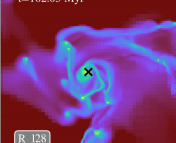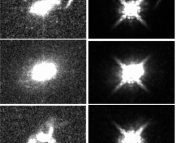SIMBA: Cosmological Simulations with Black Hole Growth and Feedback
Authors: Romeel Davé, Daniel Anglés-Alcázar, Desika Narayanan, Qi Li, Mika H. Rafieferantsoa & Sarah Appleby
First Author’s Institute: Institute for Astronomy, Royal Observatory, University of Edinburgh, U.K.
Submitted to MNRAS, available on arXiv.
The SIMBA Cosmological Simulation
Today’s post is about a new release of a simulation called SIMBA. This is the next generation of the MUFASA cosmological simulations, with some key updates and improvements (more information on cosmological simulations here). For those keen to know the details, SIMBA uses a (100h-1Mpc)3 box and 10243 gas elements. It uses a Meshless Finite Mass1 (MFM) solver and evolves dark matter and gas elements together including gravity and pressure forces.
It would be impossible to explain the vast amount of physics that goes into galaxy formation simulations in just one article, so let’s focus on what’s new and novel about the SIMBA simulations – the treatment of black holes.
Black Holes and their Host Galaxies
It’s well believed that all massive galaxies host supermassive black holes in their centres, so understanding how they grow is essential in understanding how galaxies grow and evolve. When we look at the mass of the central supermassive black hole with the mass of its host galaxy, we see a very strong correlation. Black holes are very dense, massive objects creating a deep gravitational potential which affects the orbits of stars close to it. However, the distance out to which stars are dominated gravitationally by the black hole, the so-called ‘sphere of influence’, is not big enough to account for such a tight correlation between the black hole and the properties of the galaxy as a whole. Therefore the black hole must be affecting the stars more than just gravitationally. Whilst smaller black holes are though to exist in galaxies, ‘black hole’ throughout this article refers to the central supermassive black hole in the galaxy.
Black Hole Accretion
There are two main ways in which black holes grow: mergers and accretion. Merging of the central black holes tends to arise following the merging of two galaxies, which simultaneously builds up the mass of the galaxy (i.e. the stars, gas and dust) as well as the mass of the black hole. Accretion is the ‘feeding’ of a black hole from the surrounding material within the galaxy. In order to fall into the black hole, the material must lose angular momentum. To do this, the infalling material onto the black hole forms an ‘Accretion Disk’, as visualised in Figure 1. There is however a limit to the rate at which material can fall onto a black hole, known as the ‘Eddington Accretion Rate‘2. In brief, this rate comes from a limit to hydrostatic equilibrium defined by the condition that the outwards directed force balances the inwards directed gravity.

Figure 1: Artist’s impression of the debris of a disrupted star being accreted by a supermassive black hole. Credit: NASA’s Goddard Space Flight Center
SIMBA invokes two modes of accretion. For the cooler gas with temperatures below 105K, the accretion relies on instabilities3 in the cold gas disk to drive mass inflow to the black hole. The Eddington rate is calculated assuming spherical symmetry, however we know that this accretion mechanism can be non-spherically symmetric, and so an upper limit for the accretion rate is set at 3 times the Eddington rate of the black hole (see these notes for further explanation). For temperatures above 105K, Bondi accretion4 is used, which is computed via a simplified analytic formula. At these temperatures, the gas is typically more spherically distributed and so the maximum accretion rate is limited to the Eddington rate. These two accretion rates are then simply summed and multiplied by a radiative efficiency factor, which is simply a number between 0 and 1 describing the fraction of accreted mass that is converted into energy.
Black Hole Feedback
When black holes were initially implemented in the early days of simulations of galaxy formation, it was understood that black holes interacted gravitationally and were also able to accrete material from their surroundings. However, it was found that the resulting galaxies were far bigger than the galaxies observed in our Universe, which is generally what we are trying to match. It was then hypothesised (and theoretically motivated) that an output of energy from the black hole would heat the gas and prevent star formation (remembering gas needs to be able to cool to form stars), and thus limit the size of the galaxies. This ‘output energy’ originates from the accretion disk of an actively accreting black hole (also known as active galactic nuclei (AGN)). As material falls to the centre of the black hole, it moves into a lower gravitational potential. This liberated gravitational potential energy is then converted into electromagnetic radiation. The more material you have infalling, the more energy that needs to be radiated away. This radiated energy is ‘Feedback’, and it’s now well believed it plays an important roll in galaxy formation and evolution. Significant extended AGN feedback can stop star formation all together, known as ‘quenching’.
SIMBA implements black hole feedback via kinetic bipolar outflows and X-ray energy. The kinetic feedback model has two modes, dependent on the ‘Eddington ratio’, defined as the ratio between the black hole accretion rate and the Eddington accretion rate mentioned earlier. In observational data, at high Eddington ratios, AGN are seen to drive multi-phase winds including molecular and warm ionised gas at velocities of ~ 1000 km/s. At low Eddington ratios however, AGN mostly drive hot gas in collimated jets at higher velocities. The feedback model implemented in SIMBA is therefore designed to mimic these two kinetic feedback regimes. In the latter case for the jets, observationally we only see jets from galaxies with black hole masses of above 108 solar masses. Therefore SIMBA also implements this as a threshold, which prevents low mass black holes driving high powered jets. Jets are observed to carry very hot gas, and therefore SIMBA also increases the temperature of these jet mode outflows. The X-ray energy output applies also during the jet mode, by simply inputting energy into surrounding gas of the accretion disk. This energy heats this gas, further halting star formation.

Figure 2: Temperature map projected through a random 10 Mpc/h slice from a 50 Mpc/h Simba volume, at z = 2 (left) and z = 0 (right). At z = 2, warm-hot gas traces large-scale filaments, with energetic outflows from jets seen from where the most massive galaxies and black holes reside. At z = 0, high-speed AGN outflows have shocked much of the gas well beyond the individual galaxies.
So implementing these adaptive models for accretion and feedback is all very well, but does SIMBA actually produce realistic galaxies with realistic black holes? SIMBA produces the ‘galaxy stellar mass function’ (the distribution of masses of galaxies) well from redshift (z) 6 to 3, but has a slight excess of high mass galaxies at redshift 2 to 0 when compared to observations. This suggests that their implementation of the feedback mechanisms to quench galaxies is not quite efficient enough, as their galaxies are allowed to grow too big. The authors also suggest some numerical effects present in their simulation, where smaller satellite galaxies (like the Small and Large Magellanic clouds in our own Milky Way) are merged into the larger central galaxy, primarily due to not enough resolution in the simulation.

Figure 3: Specific star formation rate (star formation rate per unit mass) against Stellar mass. The individual points show SIMBA galaxies colour-coded by their black hole to stellar mass ratio. The thick green line shows the median to star-forming galaxies. Observations at z = 0 as the grey hexbins, with the black dashed line showing the median.
Something else that the authors look how the specific star formation rate as a function of stellar mass evolves with black hole mass, as shown in Figure 3. For galaxies larger than 1010 solar masses, they see a nice trend of quenching (low star formation rates) for higher mass black holes. However, below 1010 solar masses the star formation rates are too high. Investigating into this, the authors find that these galaxies with star formation rates that are too high for some reason have not grown their black hole rapidly, which is something they will address in future work.
The authors also look at the gas fractions and metallicities and find generally good agreement with observations, however there are still some problems due to a subpopulation of their galaxies not quenching enough.
Whilst there is still work to be done to achieve strong agreements with observational relations, SIMBA tries to implement prescriptions for accretion and feedback which are more physically motivated. One of the difficulties always with these simulations is that more resolution is required to really resolve all of the processes, so we need to use sub-grid prescriptions. Large volume simulations are computationally very expensive, and resolving all of the physical processes for these volumes is currently impossible. So for now, SIMBA is state-of-the-art and will be continued to be analysed and improved for a long time to come.
1 This paper gives a discussion of different hydrodynamical solvers and describes the code SIMBA uses. Perhaps slightly hard to read, but Figure 1 along with its caption gives a nice visualisation and very brief overview of the different popular solvers.
2 This is the original paper by Eddington himself published in 1916. It gets fairly heavy on the mathematics, but the introductory pages are certainly worth reading (or the whole thing if you’re feeling brave!).
3 A really nice paper from 1975, which is relatively simple to read and gives some very nice clear explanations of thermal instabilities, particularly in section II.
4 The classic Bondi paper from 1952, which again provides a really step by step clear understanding of this approximation. In general, older papers explain the core physics much better in my opinion, so don’t be scared to delve into these key papers!




